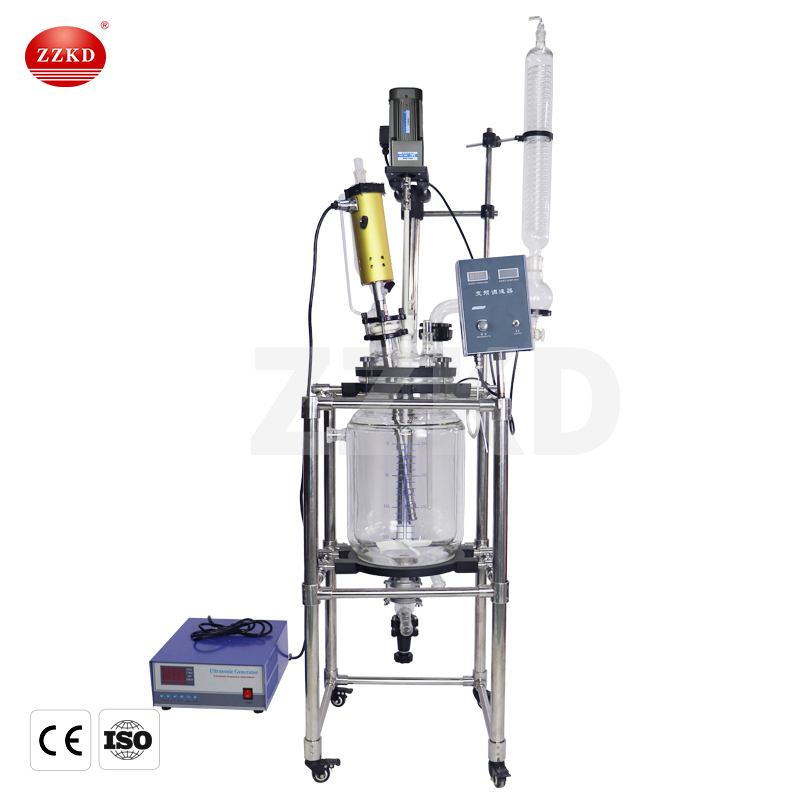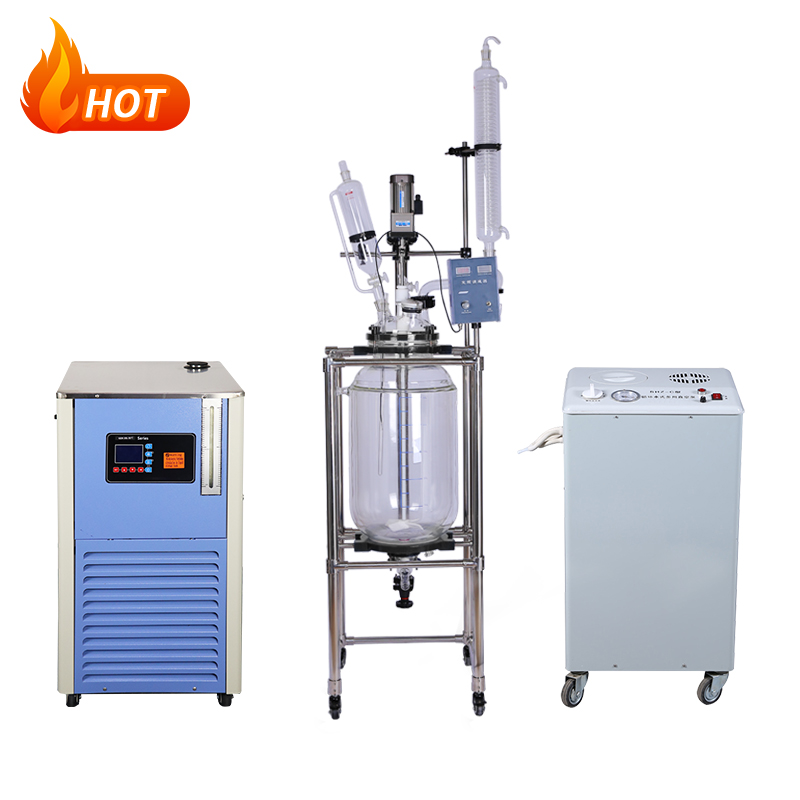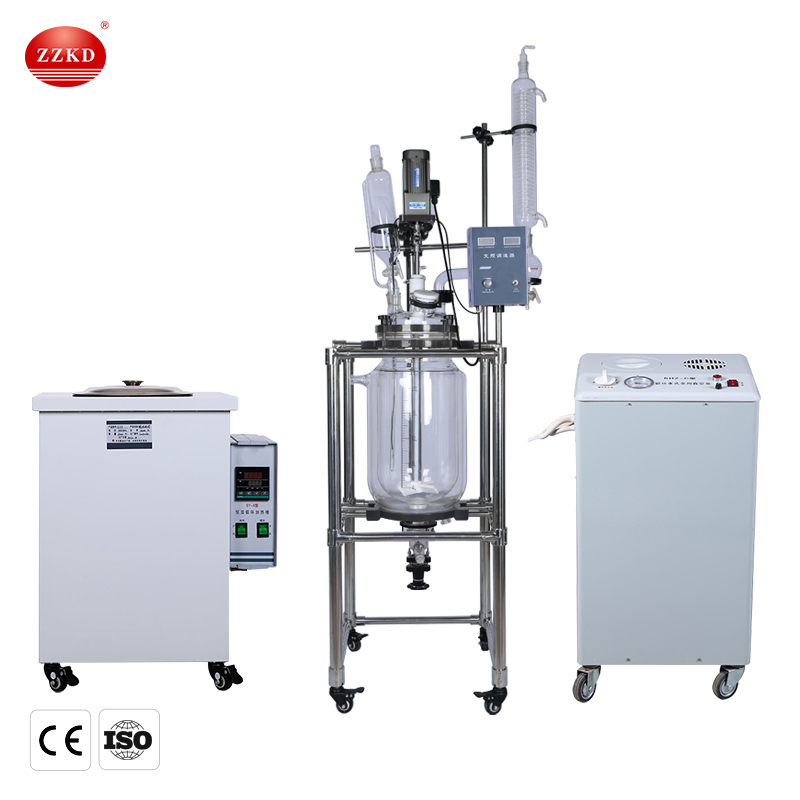Jacketed Glass Reactor Vessel
100l glass reactor vessel with stirring is one of the typical reaction equipments commonly used in chemical, pharmaceutical and food industries. Under a certain pressure and temperature, a certain volume of two (or more) liquids and liquids and solid or gas materials are mixed uniformly with the aid of a stirrer to promote their reaction. A jacketed glass reactor vessel with stirring. It is mainly composed of stirring vessel, stirring device, transmission device, shaft sealing device, support, manhole, process connection and some accessories.
The inner layer of the jacketed glass reactor vessel can be put into the reaction solvent for stirring reaction. up to 300°C) or low-temperature reaction (with corresponding low-temperature refrigeration liquid circulation system, the temperature can reach - 80°C), or an integrated heating and refrigeration cycle machine; under the set constant temperature, in a closed glass reactor , the 10l jacketed glass reactors vessel kettle can carry out stirring reaction under normal pressure or negative pressure, and can also do reflux and distillation of the reaction solution. The double-layer glass reactor is an ideal production equipment for modern chemical, pharmaceutical and material synthesis. Its design makes the experiment safer and more convenient.

Operation after the reactor is installed:
1. First, after the reactor is installed, a certain amount of nitrogen needs to be introduced to keep the pressure for 30 minutes, and then check for leakage. If there is leakage, please use soap foam to find the leakage point of the pipeline and nozzle, and release the gas after finding the leakage point. Tighten it, and run the nitrogen pressure test again to ensure that there is no leakage and then start to work normally.
2. When cooling down, water can be used for internal cooling through the cooling coil. Please note that rapid cooling is prohibited to prevent excessive temperature difference stress from causing cracks on the cooling coil and the kettle body. At the same time, when the temperature in the kettle exceeds 100 °C, the water jacket between the magnetic stirrer and the kettle cover should be connected to cooling water to ensure that the water temperature is less than 35 °C to avoid demagnetization of the magnetic steel.
3. The safety device of the jacketed glass reactor vessel adopts the positive arched metal stainless steel bursting disc, which has been tested before leaving the factory and cannot be adjusted arbitrarily. If it has been blasted and needs to be replaced, it should also be replaced in time for those that exceed the calibrated burst pressure but have not been blasted. For frequent use, it is best not to exceed 80% of the lower limit pressure of the bursting disc. When replacing, it should be noted that the convex surface of the bursting disc should face upwards.
4. After the reaction of the experimental glass reactor, it should be cooled and cooled first, and then the gas in the kettle should be released to the outside through the pipeline to reduce the pressure in the kettle to normal pressure. Please note that disassembly under pressure is strictly prohibited, and the main bolts and nuts are symmetrical. Loosen, remove and then remove the kettle cover and place it on the bracket. Special attention should be paid to protecting the sealing surface during the entire cover removal process.
5. Cleaning in the experimental glass reactor. After each operation, use the cleaning solution to remove the residue on the kettle body and the sealing surface. Do not use hard substances or rough surface items to clean the reaction kettle.

Safety operation rules for double-layer glass reactor:
1. Check whether the working voltage of the switching power supply is the same as the specifications and models of the data provided on the factory nameplate of the machine and equipment.
2. Plug in the power cord, turn on the electric switch on the inverter, and use the speed control knob to select the appropriate number of revolutions.
3. The flow of raw materials and the driving force of the motor speed may cause resonance at a certain point. Please change the number of revolutions of the motor to avoid resonance.
4. After the stirring rod is installed, be sure to rotate it by hand, and pay attention to whether the concentricity is good. If the concentricity is not good, loosen the heavy clamp, and then turn on the switch power after the clamp is correct, and adjust gradually from slow to fast. 5. Using the stirring rod adjuster, the stirring leaves can be moved up and down 5cm as required.
6. If the sealing performance of the kettle is found to be degraded, please check the rotating bearing in the agitator sleeve.
7. The glass instruments of this reaction device are all made of GG.17 low thermal expansion coefficient high temperature resistant high quality borosilicate glass to ensure safe use.
8. The interlayer on the glass kettle is connected to an external circulation port. Hot oil is used for heating reaction, and cooling liquid can be used for low temperature reaction. It is best not to use pressure steam for heating.
9. When the experiment is carried out at low temperature, the discharge valve at the bottom will be frosted. When using the valve i], it must be partially unfrozen to prevent the glass from being broken.

Maintenance of jacketed glass reactor vessel:
1. This equipment is a fragile commodity, please handle it with care when using it.
2. Check the instrument carefully before use, whether the glass bottle is damaged or not, and whether the interfaces are consistent, pay attention to handle it with care.
3. The PTFE switches everywhere should not be over-tightened, which will easily damage the glass.
4. Turn on the power switch first, and then let the machine and equipment run from slow to fast. When the machine is stopped, make the machine and equipment in a stopped state, and then turn off the switch.
5. Each interface should not be over-tightened, and should be loosened on time to avoid long-term locking that would cause the connector to die.
6. Loosen each PTFE switch after shutdown, long-term static in the working environment will deform the PTFE piston.
7. The electrical part must not enter the water, and it is strictly forbidden to get wet.
8. Be sure to buy genuine accessories from the original factory. Casual use of other accessories will cause fatal harm to the machinery and equipment.
9. When doing any repairs or inspections to the machinery and equipment, be sure to cut off the switch power supply and water source first.


